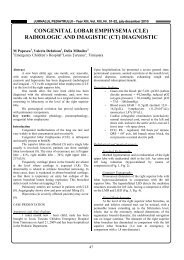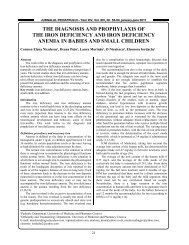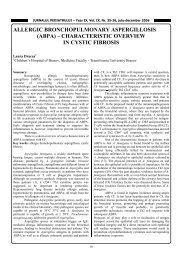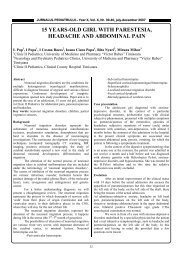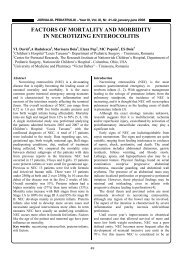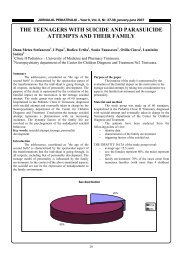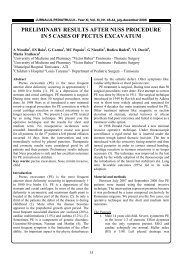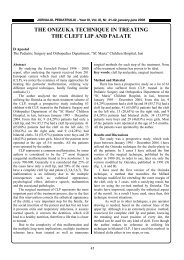address editor in chief co-editors secretary editorial board
address editor in chief co-editors secretary editorial board
address editor in chief co-editors secretary editorial board
Create successful ePaper yourself
Turn your PDF publications into a flip-book with our unique Google optimized e-Paper software.
JURNALUL PEDIATRULUI – Year XV, X<br />
, Vol. XV, Nr. 59-60<br />
60, , july<br />
j<br />
uly-december 2012<br />
<strong>in</strong>creased limb girth <strong>in</strong> KTS is ma<strong>in</strong>ly due to lymphedema<br />
and soft-tissue hypertrophy [9]. Hemangiomas <strong>in</strong> KTS may<br />
be limited to the sk<strong>in</strong> or may extend <strong>in</strong>to the subcutaneous<br />
tissue [11], as <strong>in</strong> the present case. Syndactyly, which<br />
characterizes the child, is a <strong>co</strong>mmon f<strong>in</strong>d<strong>in</strong>g <strong>in</strong> KTS [9]. The<br />
muscular hypoplasia seen <strong>in</strong> the patient’s left arm is a<br />
relatively rare f<strong>in</strong>d<strong>in</strong>g <strong>in</strong> KTS and is thought to be related to<br />
the existence of <strong>in</strong>tramuscular lesions [12].<br />
Several theories have been formulated to expla<strong>in</strong> the<br />
osseous growth that is seen <strong>in</strong> an overwhelm<strong>in</strong>g majority of<br />
KTS patients. One theory argues that it <strong>co</strong>uld be attributed<br />
to venous hypertension [13]. Another suggests that it <strong>co</strong>uld<br />
be the result of a genetic defect that leads to both vessel<br />
malformations and excess limb circumference and length<br />
[9]. A third theory proposes that a mesodermal defect dur<strong>in</strong>g<br />
fetal development results <strong>in</strong> delayed regression of the<br />
embryonic vascular reticular network <strong>in</strong> the develop<strong>in</strong>g<br />
limb, which leads to <strong>in</strong>creased blood flow (with<strong>in</strong> normal<br />
limits, however), higher bone growth rates, venous<br />
abnormalities and cutaneous nevus development [14]. Our<br />
patient’s case supports the last theory listed, as Doppler<br />
echocardiography demonstrates normal but higher blood<br />
flow <strong>in</strong> the more effected extremity versus its less affected<br />
<strong>co</strong>unterpart.<br />
On a group of 40 patients with KTS, Gloviczki et al [3]<br />
found that the average difference <strong>in</strong> length between the<br />
affected and non-affected lower extremity was 2.39 cm, with<br />
only two patients experienc<strong>in</strong>g an accentuation of more than<br />
1 cm <strong>in</strong> this difference over a two year period. The 4 cm<br />
length discrepancy between the patient’s legs and the 2 cm<br />
lengthen<strong>in</strong>g difference he experienced over the past two<br />
years ac<strong>co</strong>unt for an unusual case of KTS.<br />
Common <strong>co</strong>mpla<strong>in</strong>ts of patients with KTS, which have<br />
been experienced by our patient as well, <strong>in</strong>clude: pa<strong>in</strong>,<br />
swell<strong>in</strong>g, bleed<strong>in</strong>g, superficial thrombophlebitis, cellulitis,<br />
heav<strong>in</strong>ess and weakness <strong>in</strong> the affected limbs [9, 11]. In<br />
<strong>address</strong><strong>in</strong>g these problems, therapeutic approach of KTS is<br />
usually <strong>co</strong>nservative – <strong>co</strong>mpression garments; pa<strong>in</strong><br />
management; anti<strong>co</strong>agulant therapy when there is<br />
predisposition to thrombosis; prophylactic antibiotic therapy<br />
<strong>in</strong> recurrent cellulitis; lymphatic dra<strong>in</strong>age <strong>in</strong> cases of<br />
significant edema; and rigorous hygiene of affected limbs to<br />
prevent <strong>in</strong>fection and cellulitis [3,9,11].<br />
The case we present is particularly <strong>in</strong>terest<strong>in</strong>g as the<br />
patient has a history of hydronephrosis, splenomegaly and<br />
rectorrhagia, all of which have rarely been <strong>in</strong>dividually<br />
reported <strong>in</strong> association with KTS, and, to our knowledge,<br />
never together. Splenomegaly <strong>in</strong> KTS has been l<strong>in</strong>ked to<br />
high venous pressure due to splenic ve<strong>in</strong> stenosis [15] and/or<br />
splenic hemangioma/lymphangioma [16]. Some cases of<br />
rectorrhagia are though to occur as a result of the<br />
hypogastric ve<strong>in</strong> be<strong>in</strong>g overloaded by the posterolateral<br />
ve<strong>in</strong>s of the affected extremity, which impedes proper pelvic<br />
dra<strong>in</strong>age and leads to dilatation of hemorrhoidal ve<strong>in</strong>s and<br />
rectal bleed<strong>in</strong>g [3].<br />
Major differentials for KTS <strong>in</strong>clude Parkes Weber<br />
syndrome (PWS), Servelle-Martorell syndrome (SMS) and<br />
Proteus syndrome (PS). As demonstrated by arteriography,<br />
<strong>in</strong> KTS, <strong>co</strong>ntrary to PWS, there is absence of arteriovenous<br />
(AV) fistulae, especially at the epiphyseal plate, and there is<br />
usually no bone anomaly other than its hypertrophy [3].<br />
SMS can be excluded on the ac<strong>co</strong>unt that, while it represents<br />
an association of capillary sta<strong>in</strong>s, dilated superficial ve<strong>in</strong>s<br />
and limb circumferential hypertrophy, it is characterized by<br />
undergrowth and not overgrowth of the affected limb, as<br />
<strong>in</strong>traosseous vascular malformations result <strong>in</strong> <strong>co</strong>rtical bone<br />
and spongiosa destruction, lead<strong>in</strong>g to bony hypoplasia [4,<br />
17]. In our case, MRI reveals a normal bone structure<br />
(Figure 4). The diagnosis of PS can be elim<strong>in</strong>ated because,<br />
while patients with PS can experience the capillary, venous<br />
and lymphatic malformations of KTS, the most <strong>co</strong>mmon<br />
manifestation of PS is a <strong>co</strong>nnective tissue nevus cl<strong>in</strong>ically<br />
apparent as cerebriform thicken<strong>in</strong>g of the palms and soles,<br />
which does not characterize our patient; moreover, l<strong>in</strong>ear<br />
verru<strong>co</strong>us epidermal nevi and bra<strong>in</strong> structural<br />
malformations, which are <strong>co</strong>mmon <strong>in</strong> PS, are not seen <strong>in</strong> our<br />
patient either [4].<br />
Figure 4. MRI show<strong>in</strong>g normal bone structure.<br />
12



